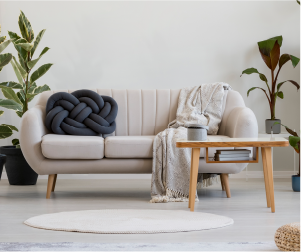Spring HVAC Tips: Indoor Air Quality and Energy-Efficient Appliances
April 29, 2021


Fresh air. Fresh perspectives. Spring is a perfect excuse to better yourself and the environments you surround yourself in. And with Earth Day in April, many of us look inward at our actions, habits and even the products and appliances we use every day to see if we can make choices that have less impact on the planet. As you look to make changes in your life this spring, start with these simple steps within your own environment’s heating and cooling systems:
Improve the Indoor Air Quality in Your Home

One term that’s taken center stage this past year? Indoor air quality. Research from Parks Associates found that 34% of U.S. broadband households are concerned about indoor air quality (IAQ)—either inside their home, outside their home or in their workplace—but 50% of U.S. broadband households have health conditions sensitive to IAQ.
For allergy-sufferers, those with asthma and individuals with respiratory conditions, good IAQ is crucial for living a comfortable life—especially in the places they frequent often, like their home or workplace. But due in no small part to the COVID-19 pandemic, the buzz around IAQ has dramatically increased among IAQ-sensitive and non-IAQ-sensitive individuals alike over the last year, with evidence showing that the virus can remain airborne in indoor environments for hours, potentially increasing in concentration over time.
“With people staying home more and with concerns of COVID-19, we are definitely seeing an increased in interest from consumers about the quality of air in their home,” says Adam Schuster, Manager, Sales Support.
The United States Environmental Protection Agency (EPA) says there are three basic strategies to improve indoor air quality:
“[Homeowners should have] the installing contractor recommend a filter that fits the application,” says Schuster. “You need to ensure that it is not creating too much static pressure in the duct system but is effective at cleaning. The duct design may require that a less efficient filter be used that requires more frequent replacement.”
Schuster and his colleague, Phil Oglesby, an Education and Content Development Manager at Rheem, encourage homeowners to do research and speak with a Rheem Pro Partner about the right solutions for them and their home, including how often you should change your filters.
“I always recommend [changing your HVAC filter] one month per inch of width,” says Oglesby. “So, a 1-inch filter should be changed monthly. For those with pets, you may have to change filters more frequently.”
Schuster elaborates and says that fiberglass filters should be changed every 30 to 60 days, and for pleated filters, every 90 to 120 days depending on the material and frequency of use. However, prior to peak seasons, like spring and allergy season, your filter should be replaced for optimal use.
Indoor Air Quality in Commercial Spaces


Your home isn’t the only place where good IAQ is important. As more and more businesses and workplaces have started reopening in anticipation of a hopeful post-pandemic era, business owners and operators should prepare to meet the new standards that employees, tenants, customers and others have come to expect when entering a building. These expectations include things like more touchless technology; decreased occupancy rates; physical distancing; and clean, ventilated and filtered air.
As an employee, tenant or customer heading back to brick-and-mortar workplace or store, you want the confidence that the building you’re entering is safe and in-tune with IAQ, now more than ever.
“More business owners are asking what they can do to improve air quality in light of the pandemic,” says Shaun Thomas, Sr. Commercial District Technical Representative. “Commercial spaces are places that many people can visit or work in—maintaining the air quality is important to maintain the health of the people in that space.”
Thomas says that most commercial buildings should be minimally serviced and checked for proper operation on a monthly basis. As with any HVAC system, regular preventative maintenance, filter changes and cleaning of registers and vents is necessary to maintain good IAQ.
Depending on the use of your commercial space, whether it’s an office, gym, grocery store or meeting space, many state governments and even local municipalities are becoming more stringent and requiring certain levels of air filtration. However, specific rules vary from region to region so it’s important to work with a professional in your area to ensure your place of work is aligned with your state and local governments’ exact rules.
Invest in Sustainable HVAC Solutions for Your Home


As you continue to look to make fresh changes and improvements in your everyday life coming into the spring season, investing in more energy-efficient appliances for your home will not only save you money on utility bills but also helps you work towards a more sustainable future.
Rheem has been awarded the 2021 ENERGY STAR Partner of the Year from the EPA and the U.S. Department of Energy and has been focused on engineering solutions with sustainability in mind—from material selection to smart features to responsible recycling.
“We are committed to continuous innovation in our product portfolio that strives to exceed industry efficiency standards where possible,” says Stacey Gearhart, Rheem’s Vice President of Product Management and Channel Marketing. “We want to reduce our customers’ carbon footprint while also reducing their energy bills.”
When you invest in ENERGY STAR–certified products, you gain numerous benefits, like using less energy, saving more money and creating a more comfortable indoor environment.
“ENERGY STAR rated products definitely operate with a higher efficiency than standard products, which can help improve utility costs,” says Schuster. “Also, since these are of the higher efficiency category, a lot of these products are multi- or variable-speed type products. These can create an indoor environment with more constant temperature, help control humidity and help stratify the air in the home, which helps minimize hot and cold spots.”
Schedule a time to meet with a Rheem Pro Partner, who can advise you how to improve your residential and commercial indoor air quality, as well as provide recommendations on Rheem ENERGY STAR-certified products for your home.

























